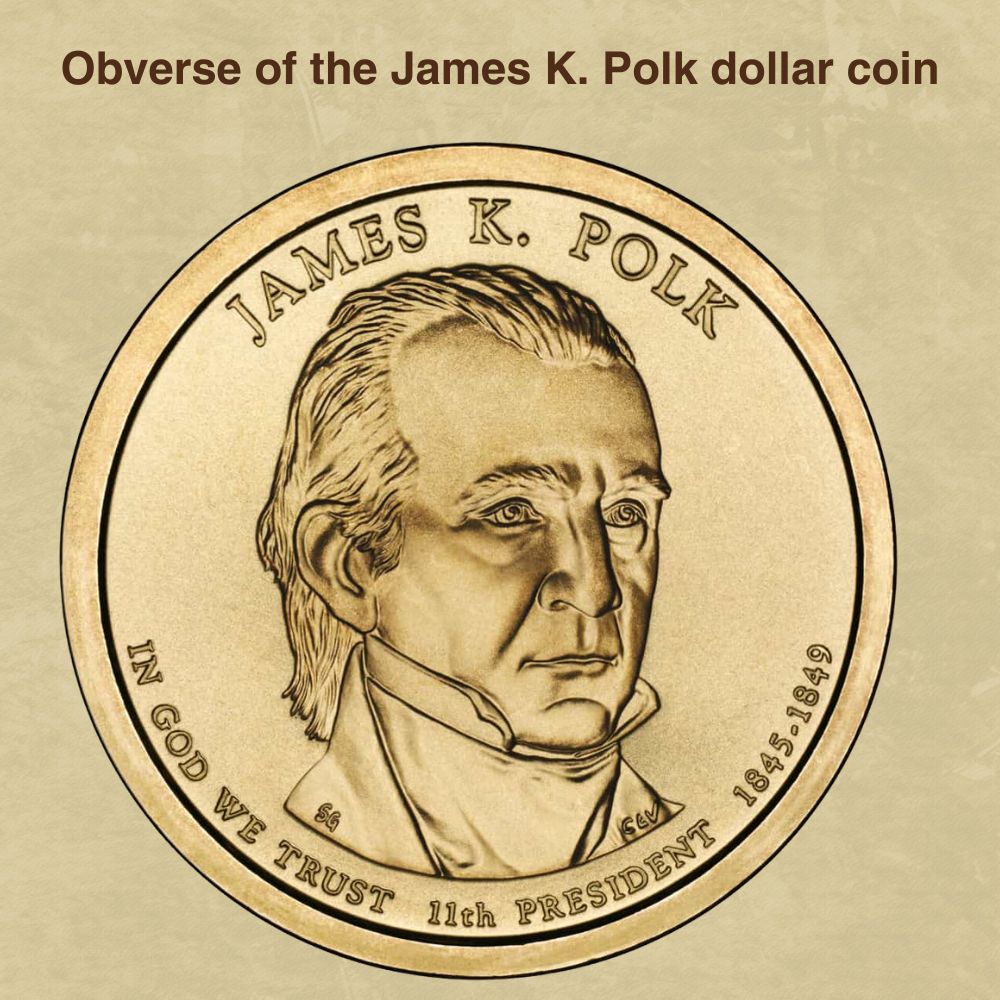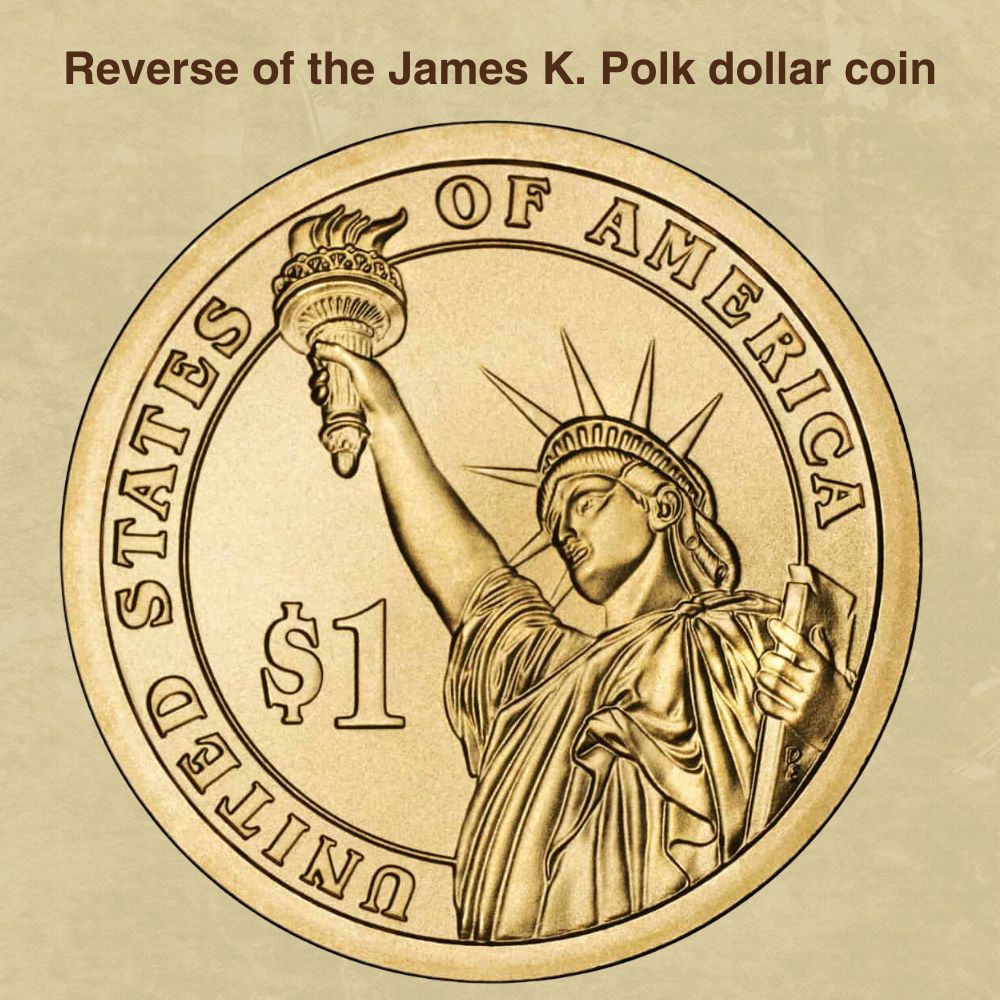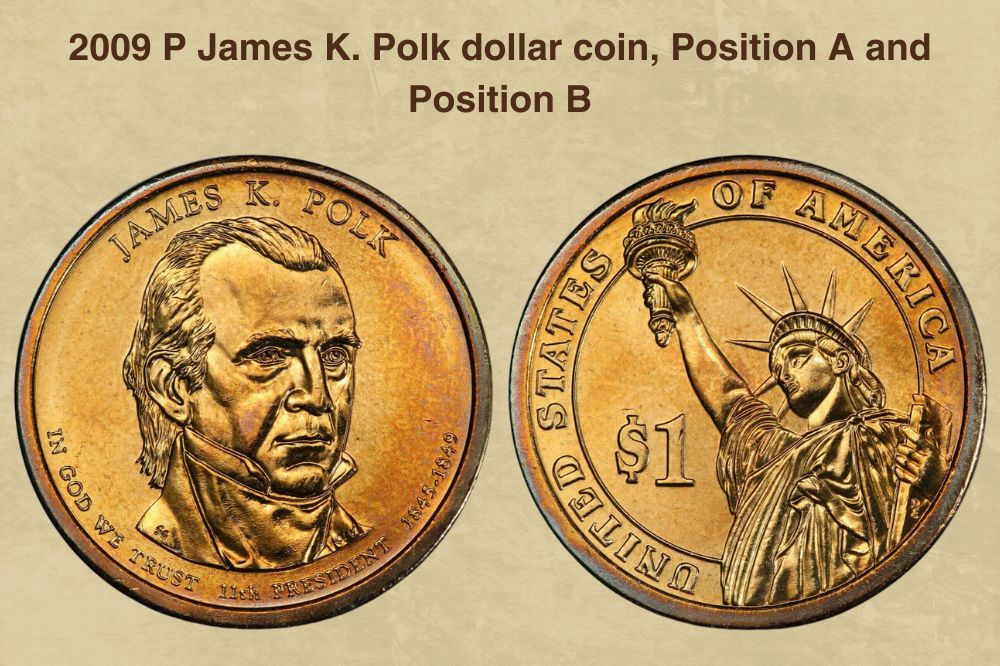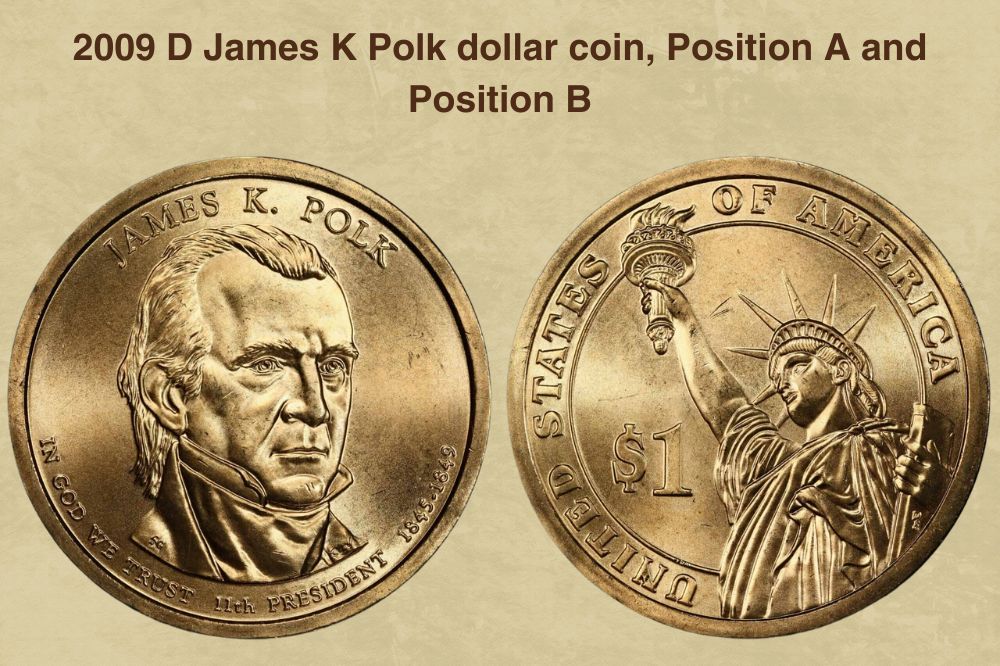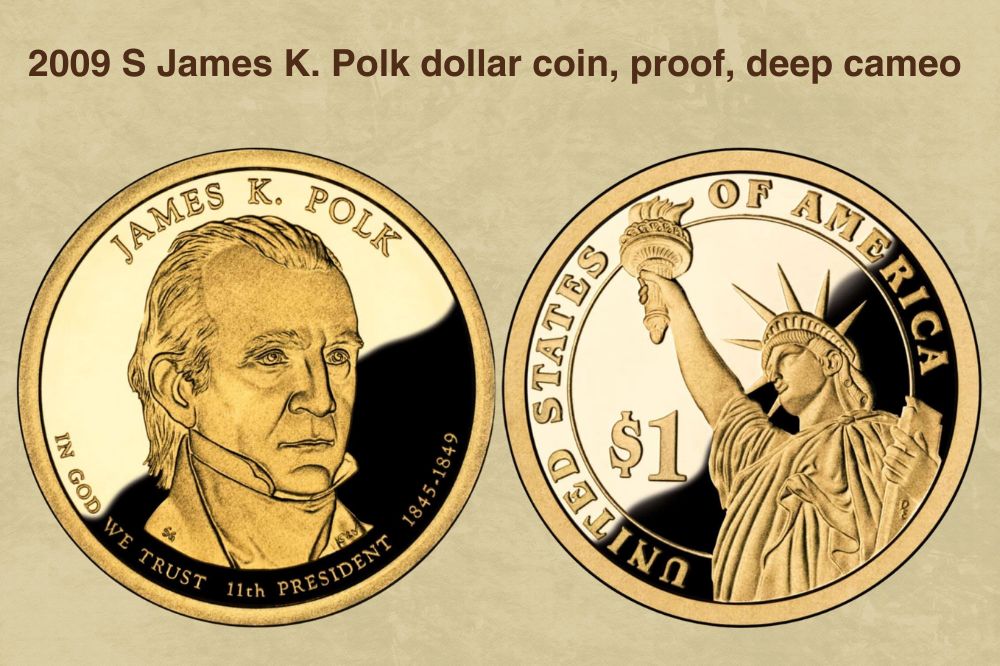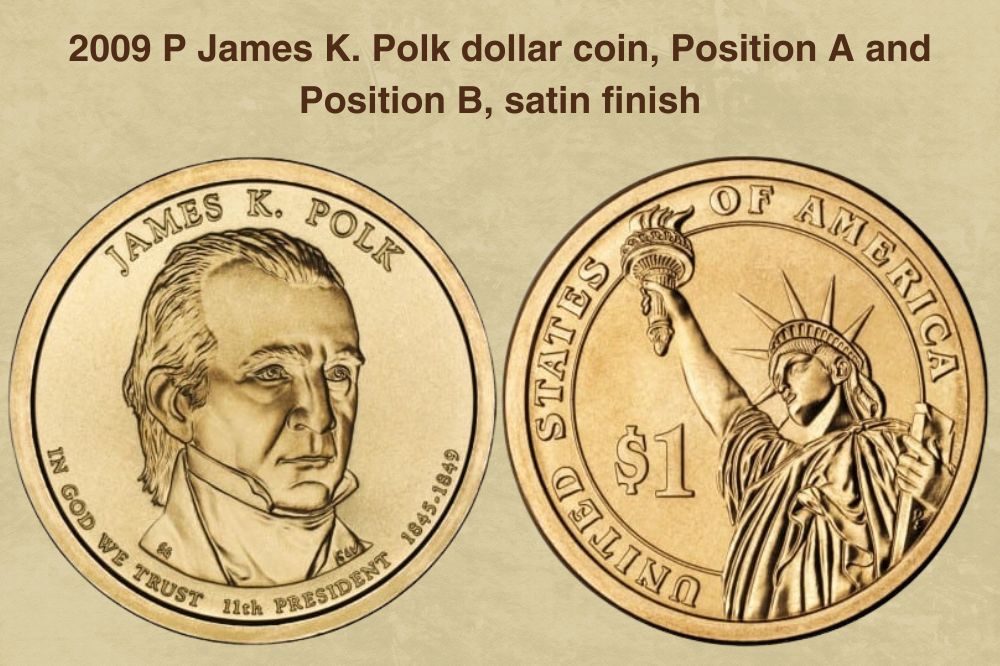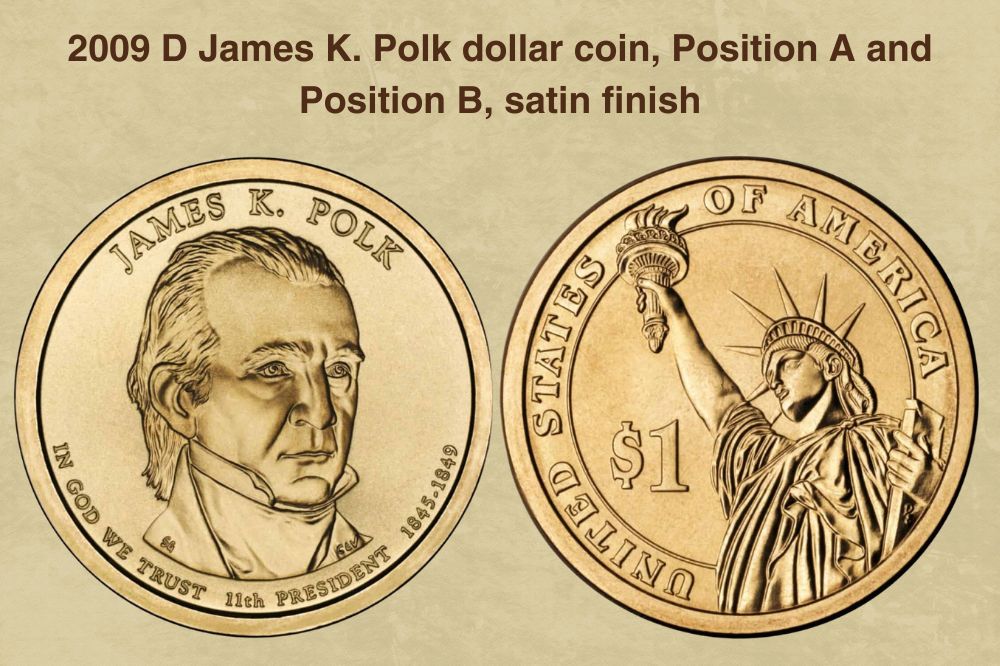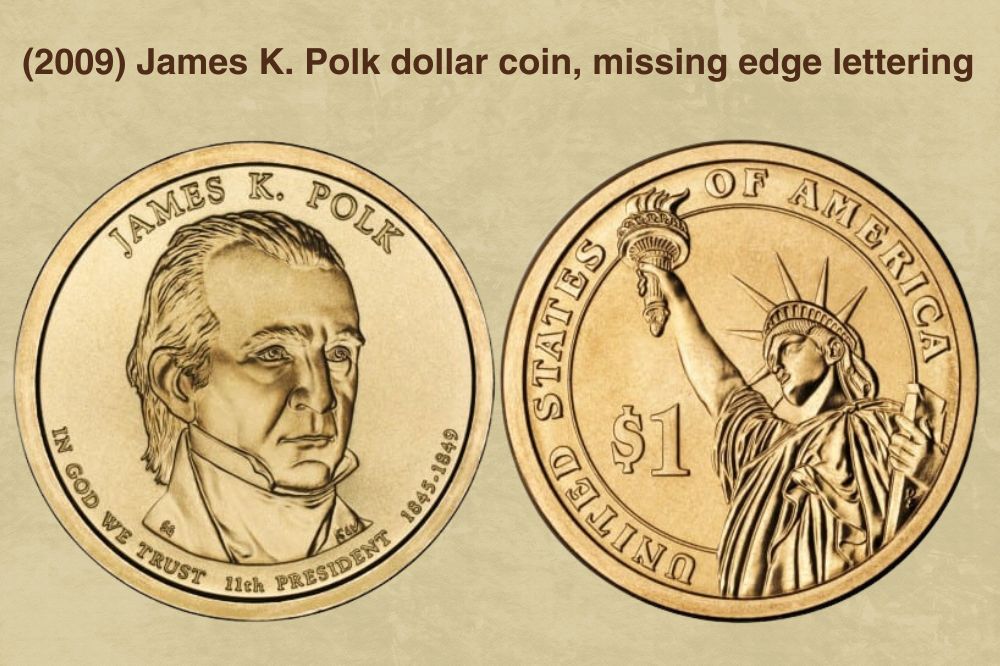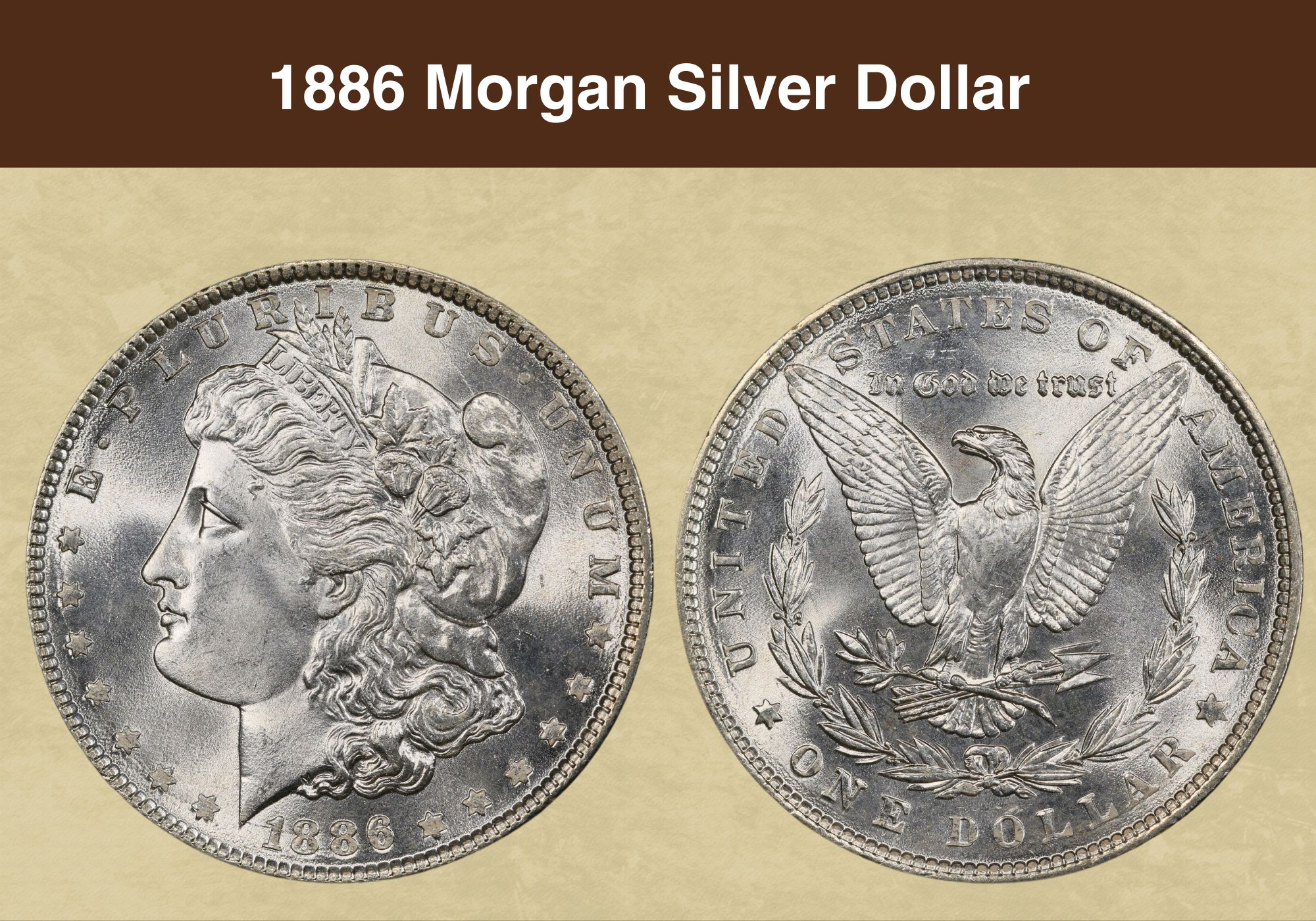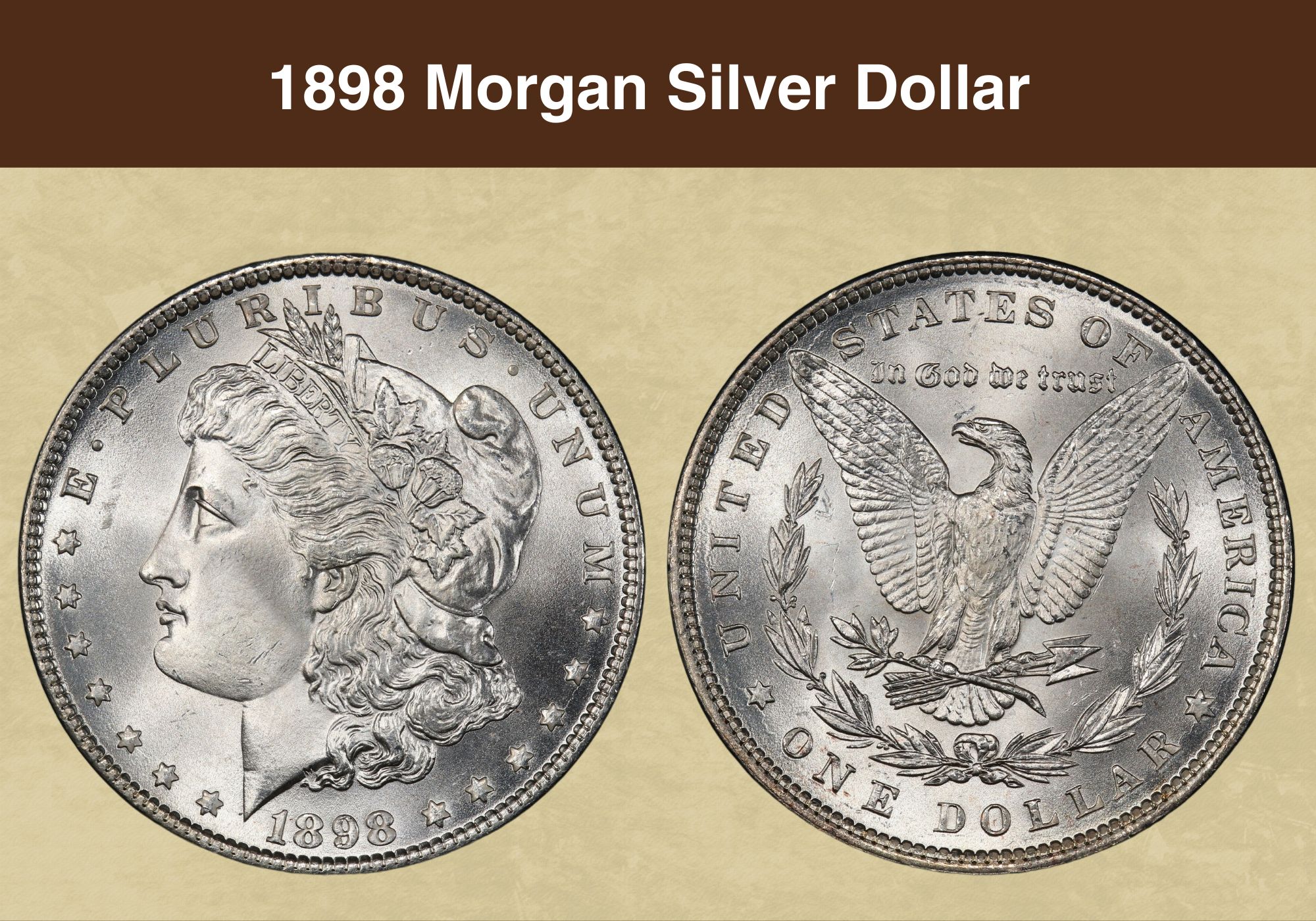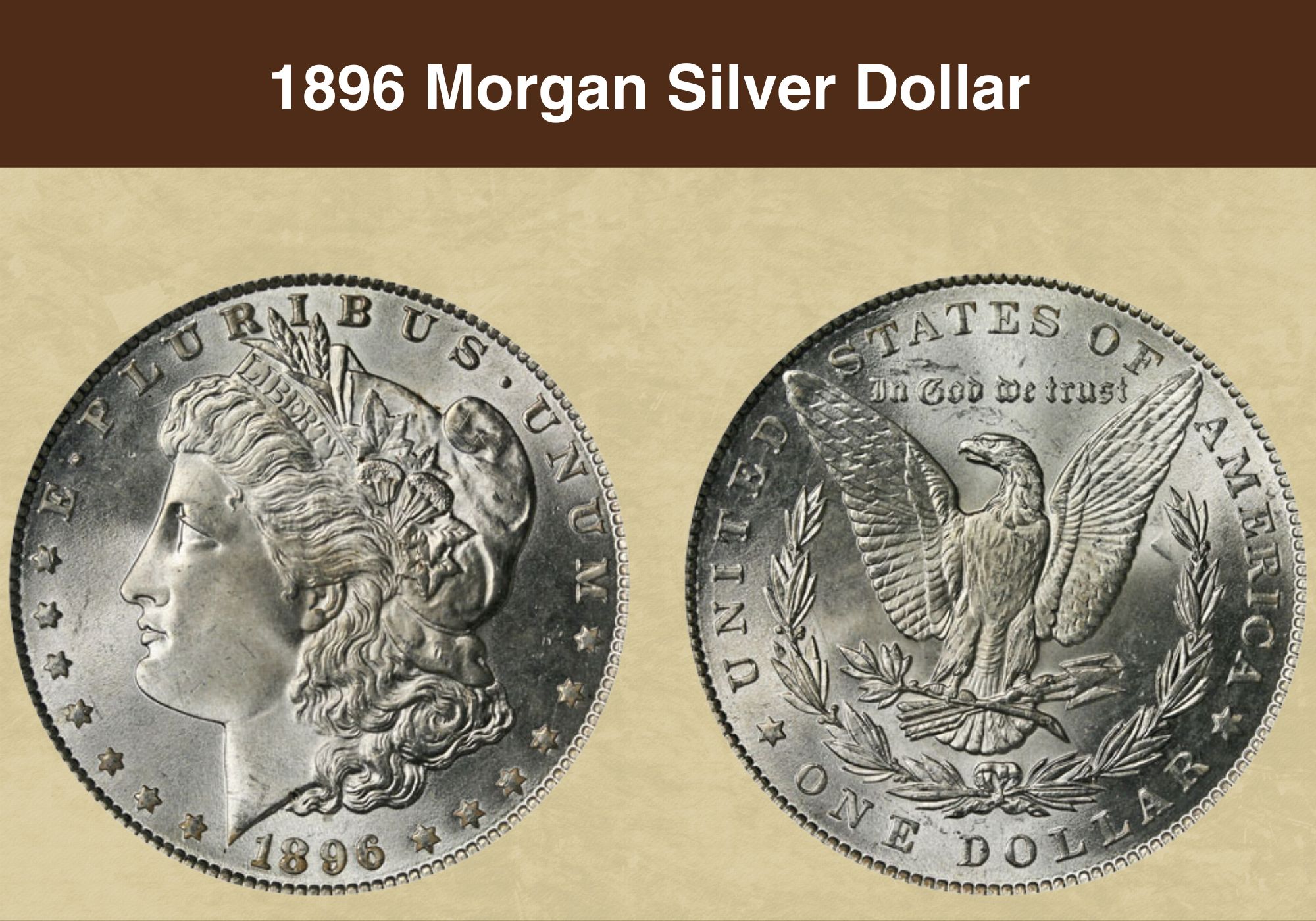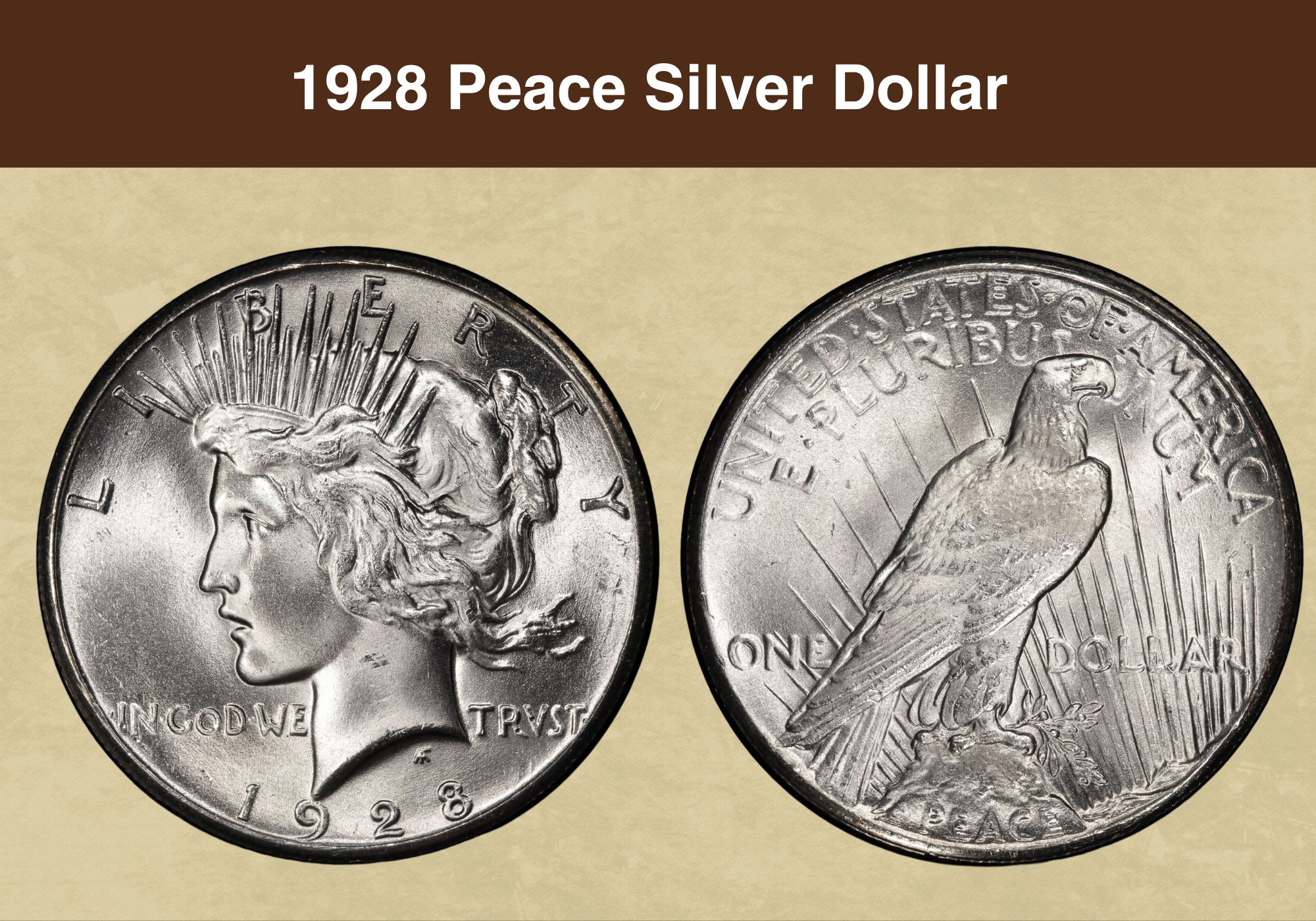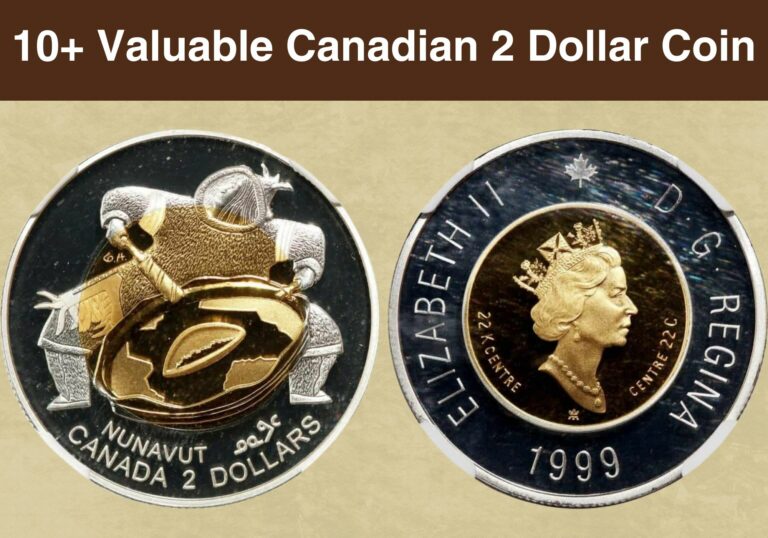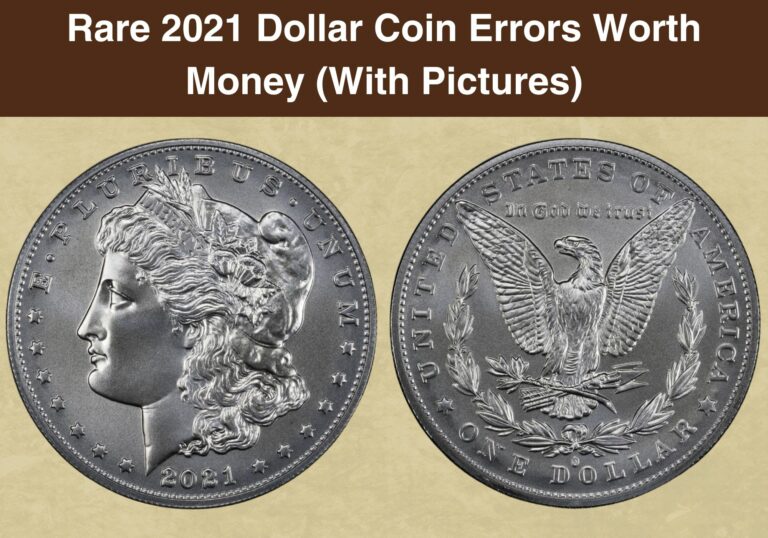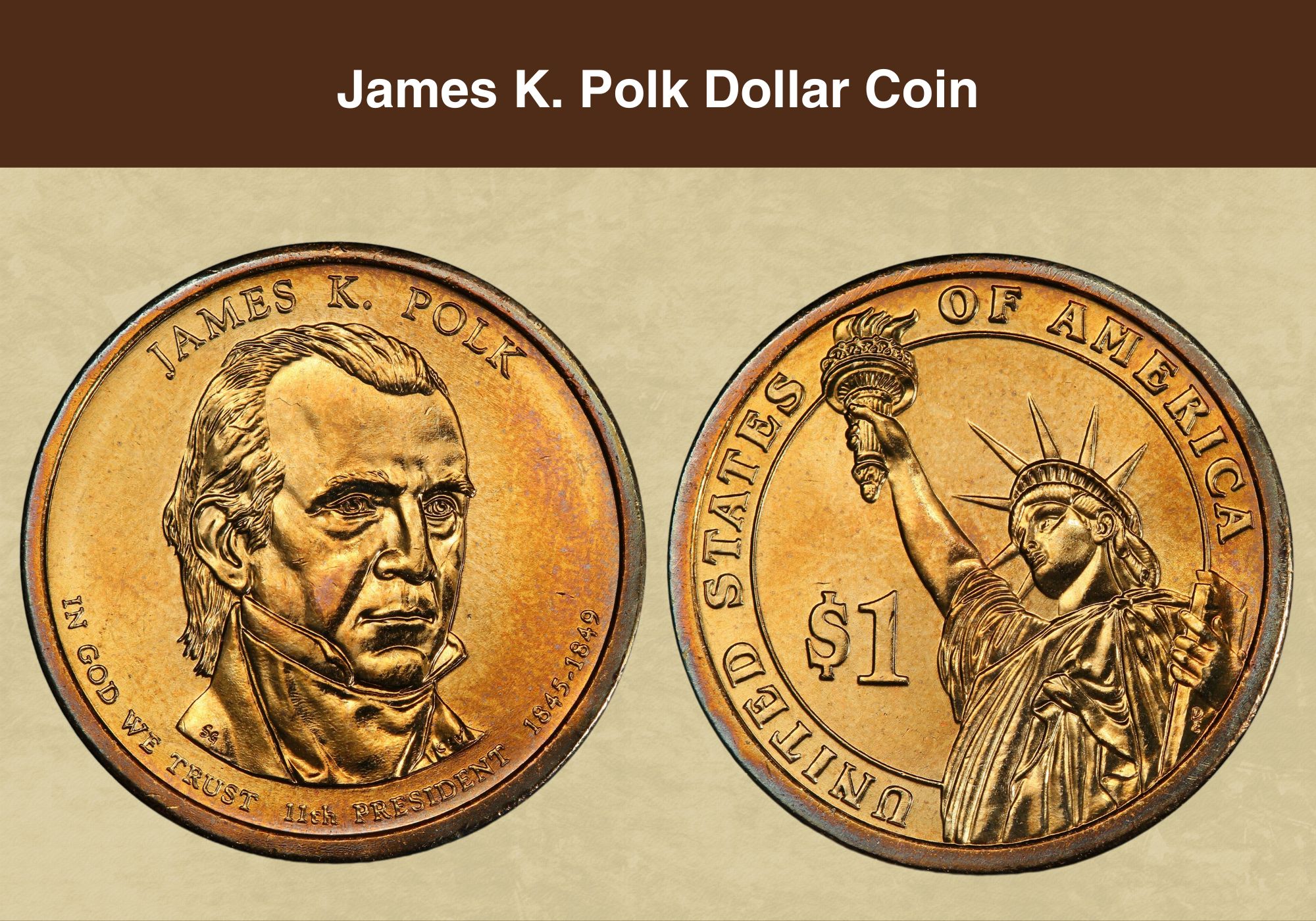
Coin Value Contents Table
In 2009, the US Mint issued a coin celebrating President James K. Polk. It’s an interesting coin and an attractive gold color. But is it valuable?
We’re going to investigate the James K. Polk dollar coin value. We’ll find out about the difference between a standard example and something collectable. And we’ll learn just how much the most valuable coins can be worth.
Ready to learn more? Read on!
James K. Polk Dollar Coin Value Chart |
|||||
| Type | Circulated | MS60 | MS65 | MS66 | MS67 |
| 2009 P James K. Polk Dollar Coin, Position A Value | $1 | $3 | $7 | $10 | $25 |
| 2009 P James K. Polk Dollar Coin, Position B Value | $1 | $3 | $7 | $12 | $70 |
| 2009 D James K. Polk Dollar Coin, Position A Value | $1 | $1 | $6 | $10 | $350 |
| 2009 D James K. Polk Dollar Coin, Position B Value | $1 | $3 | $8 | $15 | ? |
| PR60 | PR63 | PR68 | PR69 | PR70 | |
| 2009 S James K. Polk Dollar Coin, Proof, Deep Cameo Value | $1 | $3 | $5 | $12 | $35 |
| SP60 | SP63 | SP65 | SP68 | SP69 | |
| 2009 P James K. Polk Dollar Coin, Position A, Satin Finish Value | $3 | $4 | $5 | $12 | $1,000 |
| 2009 P James K. Polk Dollar Coin, Position B, Satin Finish Value | $3 | $4 | $5 | $18 | $750 |
| 2009 D James K. Polk Dollar Coin, Position A Satin Finish Value | $3 | $4 | $5 | $18 | $500 |
| 2009 D James K. Polk Dollar Coin, Position B, Satin Finish Value | $3 | $4 | $5 | $18 | $375 |
History of the James K. Polk dollar coin
2007 saw the launch of a new series of dollar coins honoring the presidents of the United States. Each coin was to be issued for three months, with the order mirroring that in which the presidents had taken office.
To be eligible for inclusion, the individual had to have died at least two years before the coin was minted. The original series came to an end in 2016, with the coin featuring Ronald Reagan. But it was briefly revived in 2020 after the death of George H. W. Bush.
As the eleventh president, James K. Polk’s coin was also the eleventh in the series. It was launched in August 2008. Like all the Presidential series, it featured a portrait of the relevant president on the obverse, and an image of the Statue of Liberty on the reverse.
Over 88 million regular coins were struck, as well as proofs and special strikes for collectors. The Mint facilities at Denver and Philadelphia produced the business and special strikes, while San Francisco minted the proofs.
Alongside the coin bearing James K. Polk’s image, a companion coin was issued honoring his wife, Sarah Polk. This showed husband and wife working together at a desk in the White House.
And unusually, a third dollar coin was also produced at the same time. The Sacagawea dollars were issued throughout the Presidential series, with legislation stipulating that they should account for a third of the dollars produced. This proportion was later reduced to one fifth.
Also read: 12 Most Valuable One-Dollar Coin Worth Money
Features of the James K. Polk dollar coin
Obverse of the James K. Polk dollar coin
The obverse of the James K. Polk dollar carries the image of the President himself. He’s shown three-quarters on, staring straight ahead. And despite being 50 when he took up the presidency, he has a rather youthful look.
The portrait was the work of Susan Gamble, an artist working at the US Mint. Her initials appear on the lower edge of his right-hand lapel.
Polk’s name arches above his portrait. The motto “In God We Trust” appears below it, alongside the inscription “11th President” and the years in which he held office, 1845-1849.
Reverse of the James K. Polk dollar coin
The design on the reverse is shared with all the dollar coins in the Presidential series. It’s the work of an artist called Don Everhart, and it shows the Statue of Liberty viewed from below.
The design emphasizes Liberty’s outstretched arm and the torch she holds. Its official title is “Liberty Enlightening the World”.
The words “United States of America” circle the design, while the denomination, “$1”, is inscribed below Liberty’s arm. The lettering is in upper case, and the chosen font was ITC Benguiat.
Other features of the James K. Polk dollar coin
One of the first things you notice about the James K. Polk dollar coin is its color. It’s an attractive shade of pale gold – but it’s not made of real gold.
The coin’s core is pure copper, and it’s the cladding which gives it the gold color. That’s formed from an alloy of copper, manganese, zinc and nickel.
Each coin weighs 8.1 grams and measures 26.5 millimeters across.
The Polk dollars (and all the Presidential dollar coins) are inscribed with lettering on their edge. This includes the date of issue and the mint mark. If the coin was struck in Denver, it will be marked with a “D”, if Philadelphia, “P”, or if San Francisco, “S”.
This YouTube video from the Museum of Money zooms in on both sides of the James K. Polk dollar coin, so you can see it in detail.
Also read: 14 Most Valuable Coins In Circulation
James K. Polk dollar coin value guides
2009 P James K. Polk dollar coin, Position A and Position B value
More James K. Polk dollar coins were struck in Philadelphia than any of the other Mint facilities. They included 46,620,000 business strike coins. And those are classified as either Position A or Position B.
In the vast majority of cases, which type you have won’t affect how much it’s worth. Because so many coins were struck, all those in circulated condition are worth only their face value. And even in mint state – coins that have never been circulated – most coins aren’t worth much more.
Coin grades run from 1 for the poorest condition (but still identifiable) examples, through to 70 for flawless coins.
MS65 – the MS stands for “mint state – is the lowest level at which a coin is considered “gem quality”. And the independent coin graders, the PCGS, value a Philadelphia Polk dollar graded MS65 at only $7.
But small differences in grading can mean a big difference in value. Go up two grades, and you’ll find the finest Philadelphia Polk coins known to exist. And being “best in class” means collectors are prepared to pay a lot more to acquire them.
At this level, it also becomes important to know whether you have a Position A or Position B coin. These labels refer to the orientation of the lettering on the coin edge. If it reads upside down when the President’s face is on top, it’s a Position B coin. If the right way round, it’s Position A.
To date, the PCGS has graded 25 Position A coins at MS67, and those are valued at $25 apiece. But Position B coins graded at the same level are worth around $70 each.
2009 D James K Polk dollar coin, Position A and Position B value
Denver produced fewer business strikes than Philadelphia, just short of 42 million. But that’s still a hefty total, and Denver Polk dollars are easy to come by. They can be identified by the mint mark – a “D” on the coin edge.
As with their Philadelphia counterparts, circulated coins won’t be worth more than their face value. And most mint state coins are modestly priced too.
The lowest level mint state coins, those graded MS60, are worth around $1, rising to $10 at MS66. But while those coins are easy to come by, the finest examples, graded MS67, are much rarer. And they’re more valuable than the Philadelphia equivalents.
Again, the orientation of the edge lettering may make a difference to the value for these top quality coins.
An MS67 Denver Polk dollar with the lettering in Position A is valued at an impressive $350 by the PCGS. Unfortunately, the coin grading service doesn’t estimate a value for a Position B dollar at the same grade.
2009 S James K. Polk dollar coin, proof, deep cameo value
The San Francisco Mint facility produced over 2.8 million proof Polk dollar coins in 2009. These were made using specially prepared dies and highly polished planchets. The result was attractive, high quality coins that were targeted at collectors.
But because of that, they were also stored carefully away, and remain easy to find. The result is that it’s possible to acquire extremely good coins without spending a lot of money.
A proof Polk dollar graded PR60 is worth only its face value. That rises to $3 at PR63, $4 at PR65, and $5 at PR68. Even perfect coins aren’t that rare. As such, it’s possible to pick up a flawless PR70 proof for around $35.
2009 P James K. Polk dollar coin, Position A and Position B, satin finish value
It wasn’t just the standard business strike coins that were produced at Philadelphia. The Mint facility there also produced coins for Special Mint Sets. Like the proofs, these were aimed at collectors. And to distinguish them from other coins, they had a beautiful satin finish.
Just as with the regular coins, the coin edge lettering may be in either Position A or Position B. But at grades up to SP68, the difference doesn’t affect value.
At SP68, however, there’s a modest divergence. At that level, Position A dollars are valued by the PCGS at $12. If the lettering is in Position B, coins are worth around $18 per cent more.
But values swap for the crème de la crème of Philadelphia Polk dollars, graded SP69. The PCGS values Position A coins at $1,000, while Position B coins are worth around $750.
2009 D James K. Polk dollar coin, Position A and Position B, satin finish value
The special strike coins with a satin finish were also minted in Denver. Just over 784,000 of those coins were struck. And values at most grades are the same as for the Philadelphia equivalents.
At SP68, the value mirrors the Philadelphia Position B examples, at $18. But at SP69, the orientation of the edge lettering again has a big impact on value.
A Denver Position A coin will be worth $500 at this level, while a Position B will be worth around $375.
Also read: Top 10 Most Valuable Morgan Silver Dollar Worth Money
James K. Polk dollar coin error
(2009) James K. Polk dollar coin, missing edge lettering
Inscribing coin edges proved to present some difficulties for the Mint. The coins were supposed to pass through what’s known as a Schuler machine to apply the lettering. But a small number missed this part of the process and were released into the world with blank edges.
Because the mint mark should have appeared on the edge, it’s impossible to say whether they were struck in Denver or Philadelphia. The key elements in determining the value of one of these error coins are its condition and quality.
At the time of writing, a business strike Polk dollar with missing edge lettering was being offered for sale on eBay. It had been graded MS67 by the independent coin assessors, the NGC. That’s also the top grade for this error at the PCGS.
And if you wanted to add it to your collection, it would cost $400.
2009 James K. Polk, weak edge lettering
Sometimes the Polk dollars made it to the Schuler machine but were weakly struck. As a result, the edge lettering was partial or faint. While not generally as valuable as coins where the lettering is missing altogether, these are still collectable.
Both the Denver and Philadelphia Mint facilities produced these errors. In Philadelphia, weak strikes appeared on coins with both Position A and Position B edge lettering. In Denver, the only examples to have so far come to light are on Position A coins.
For the Philadelphia examples, the position of the edge lettering doesn’t affect value. This ranges from $30 for coins graded MS63, to $350 for those graded MS67.
The Denver coins to have been certified so far range from MS63 to MS65. The former is valued at the same level as its Philadelphia equivalent, $30. And despite being two points lower than Philadelphia’s best-in-class examples, a coin graded MS65 is still worth about $300.
Check out this YouTube video from Couch Coin Clips to see more examples of errors in the Presidential dollars series. At 1:09, there’s a Denver James K. Polk dollar with an unusual die adjustment error.
FAQs
Is the James K. Polk dollar worth anything?
While they’re interesting coins, most James K. Polk dollars aren’t worth more than their face value. That’s because they were minted in very large numbers. And even in very good condition, they’re relatively easy to find.
There are exceptions, though. If you have a coin that’s graded at the very highest level, with none finer known to exist, it will carry a significant premium. Coins of this kind vary in value from $25 to nearly $1,000, depending on their mint mark and type.
And some error coins can be valuable too. Examples in high grades can be worth several hundred dollars.
What is a James Polk dollar coin made of?
The James Polk dollar may be gold in color, but it’s not made of gold. The core of the coin is pure copper. And the yellow color comes from the cladding. That’s a mixture of copper, manganese, zinc and nickel.

